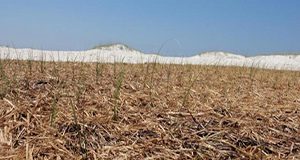Perennial coastal grasses such as sea oats have long been recognized as the biological engineers of our increasingly stressed beaches and coastal dunes. Sea oats build dunes by capturing blowing sand and stabilizing it, and they’re often planted after dunes have been eroded, fragmented, or destroyed. Managers have tried commercial fertilizers and water-absorbing gels to ensure planted sea oats survive and thrive, but these products are not always effective and can be expensive. Removal of natural beach litter, called “wrack” and defined as “algae, grasses, driftwood, fruits, seeds, and carrion, along with cultural litter,” has frequently had the undesired effect of weakening the establishment and growth of sea oats. A relatively cheap and effective method to restore them is to reproduce the beneficial effects of this beach litter with “surrogate wrack.” This 4-page fact sheet written by Natalie Hooton, Debbie Miller, Mack Thetford, and Sean Claypool and published by the Department of Wildlife Ecology and Conservation describes the promising results of a study into the feasibility and effectiveness of surrogate wrack to help sea oats become established and grow more quickly and vibrantly to restore dunes and beaches.
edis.ifas.ufl.edu/uw409
Tag: Dune Restoration
ENH1157/EP417 Railroad Vine: Ipomoea pes-caprae, a Florida Native Plant
ENH1157,a 7-page illustrated fact sheet by Stephen H. Brown and Joy Hazell, describes this pantropic vine found on beaches and dunes throughout peninsular Florida — geographic distribution, ecological function, growth habit, morphology and reproduction, and planting and maintenance guidelines. Includes references. Published by the UF Department of Environmental Horticulture, February 2010.
http://edis.ifas.ufl.edu/ep417
